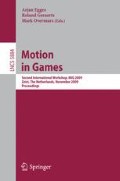Abstract
This paper presents an automatic turns detection and annotation technique which works from unlabeled captured locomotion. Motion annotation is required by several motion capture editing techniques. Detection of turns is made difficult because of the oscillatory nature of the human locomotion. Our contribution is to address this problem by analyzing the trajectory of the center of mass of the human body into a velocity-curvature space representation. Our approach is based on experimental observations of carefully captured human motions. We demonstrate the efficiency and the accuracy of our approach.
Access this chapter
Tax calculation will be finalised at checkout
Purchases are for personal use only
Preview
Unable to display preview. Download preview PDF.
References
Lee, J., Chai, J., Reitsma, P.S.A., Hodgins, J.K., Pollard, N.S.: Interactive control of avatars animated with human motion data. ACM Trans. Graph. 21(3), 491–500 (2002)
Kovar, L., Gleicher, M., Pighin, F.: Motion graphs. ACM Trans. Graph. 21(3), 473–482 (2002)
Arikan, O., Forsyth, D.A., O’Brien, J.F.: Motion synthesis from annotations. ACM Trans. Graph. 22(3), 402–408 (2003)
Shin, H.J., Oh, H.S.: Fat graphs: constructing an interactive character with continuous controls. In: SCA, pp. 291–298 (2006)
Safonova, A., Hodgins, J.K.: Construction and optimal search of interpolated motion graphs. ACM Trans. Graph. 26(3), 106 (2007)
Rose, C., Cohen, M.F., Bodenheimer, B.: Verbs and adverbs: Multidimensional motion interpolation. IEEE CGA 18(5), 32–40 (1998)
Park, S.I., Shin, H.J., Shin, S.Y.: On-line locomotion generation based on motion blending. In: SCA, pp. 105–111 (2002)
Park, S.I., Shin, H.J., Kim, T.H., Shin, S.Y.: On-line motion blending for real-time locomotion generation: Research articles. Computer Animation and Virtual Worlds 15(3-4), 125–138 (2004)
Glardon, P., Boulic, R., Thalmann, D.: Pca-based walking engine using motion capture data. In: Computer Graphics International, pp. 292–298 (2004)
Kwon, T., Shin, S.Y.: Motion modeling for on-line locomotion synthesis. In: SCA, pp. 29–38. ACM, USA (2005)
Treuille, A., Lee, Y., Popović, Z.: Near-optimal character animation with continuous control. ACM Trans. Graph. 26(3) (2007)
Glaister, B., Bernatz, G., Klute, G., Orendurff, M.: Video task analysis of turning during activities of daily living. Gait & Posture 25(2), 289–294 (2007)
Taylor, M., Dabnichki, P., Strike, S.: A three-dimensional biomechanical comparison between turning strategies during the stance phase of walking. Human Movement Science 24(4), 558–573 (2005)
Olivier, A.H., Crétual, A.: Velocity/curvature relations along a single turn in human locomotion. Neuroscience Letters 412(2), 148–153 (2007)
Boulic, R., Ulicny, B., Thalmann, D.: Versatile walk engine. Journal of Game Development 1, 29–52 (2004)
Muller, M., Baak, A., Seidel, H.: Efficient and robust annotation of motion capture data. In: SCA (2009)
Kwon, T., Shin, S.Y.: A steering model for on-line locomotion synthesis. Computer Animation and Virtual Worlds 18(4-5), 463–472 (2007)
Shiratori, T., Nakazawa, A., Ikeuchi, K.: Rhythmic motion analysis using motion capture and musical information, pp. 89–94 (2003)
Fusco, N., Crétual, A.: Instantaneous treadmill speed determination using subject’s kinematic data. Gait & Posture 28(4), 663–667 (2008)
Hase, K., Stein, R.: Turning strategies during human walking. Journal of Neurophysiology 81(6), 2914–2922 (1999)
Sedgeman, R., Goldie, P., Iansek, R.: Development of a measure of turning during walking. In: Advancing rehabilitation: Proceedings of the inaugural conference of the faculty of health sciences. La Trobe University (1994)
Choi, M.G., Lee, J., Shin, S.Y.: Planning biped locomotion using motion capture data and probabilistic roadmaps. ACM Trans. Graph. 22(2), 182–203 (2003)
Author information
Authors and Affiliations
Editor information
Editors and Affiliations
Rights and permissions
Copyright information
© 2009 Springer-Verlag Berlin Heidelberg
About this paper
Cite this paper
Olivier, AH., Kulpa, R., Pettré, J., Crétual, A. (2009). A Velocity-Curvature Space Approach for Walking Motions Analysis. In: Egges, A., Geraerts, R., Overmars, M. (eds) Motion in Games. MIG 2009. Lecture Notes in Computer Science, vol 5884. Springer, Berlin, Heidelberg. https://doi.org/10.1007/978-3-642-10347-6_10
Download citation
DOI: https://doi.org/10.1007/978-3-642-10347-6_10
Publisher Name: Springer, Berlin, Heidelberg
Print ISBN: 978-3-642-10346-9
Online ISBN: 978-3-642-10347-6
eBook Packages: Computer ScienceComputer Science (R0)

